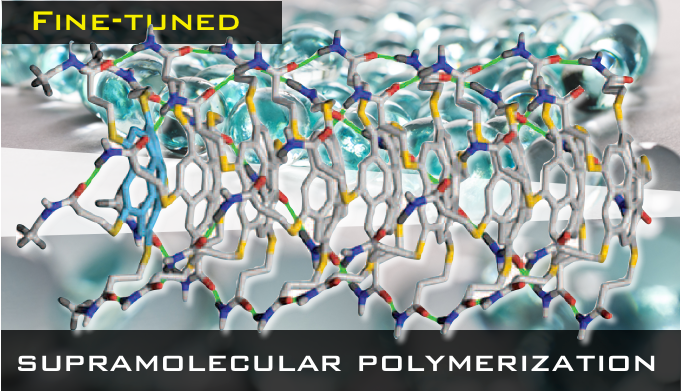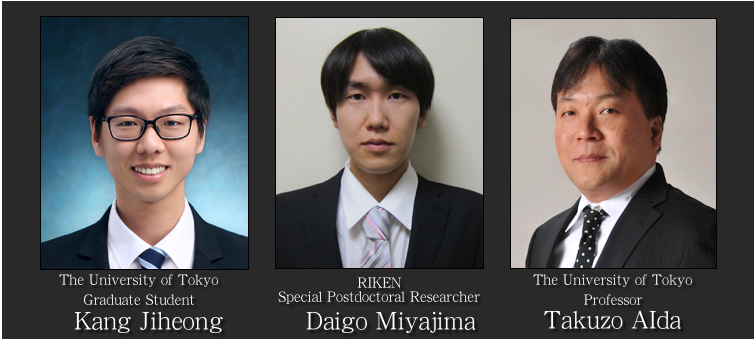A class of polymeric materials called supramolecular polymers is drawing an attention in recently years.
In contrast to “conventional” polymers, which consist of covalently linked monomeric units, supramolecular polymers consist of monomers that are held together by noncovalent interactions such as hydrogen bond and π-π interaction.
Though these polymers based on noncovalent bonds are naturally prone to reverting back to monomers depending on the conditions, they are synthetically very attractive if the polymerization can somehow be made irreversible. Because the formation of noncovalent bonds among monomers is driven solely by their property and through spontaneous self-assembly, these polymers can be prepared, in essence, by simply mixing the monomers under certain sets of conditions.
As attractive as these supramolecular polymers seem, there is one problem: It has been difficult to prepare polymers with uniform length and size (with uniform distribution of molecular weight).
A few weeks ago, a new synthetic strategy that took a step towards solving this problem was reported in Science from the joint research group including Dr. Daigo Miyajima of RIKEN Center for Emergent Matter Science, Professor Takuzo Aida and Jiheong Kang of The University of Tokyo, and Professor Yoshihisa Inoue of Osaka University.
“A rational strategy for the realization of chain-growth supramolecular polymerization”
Kang, J.; Miyajima, D.; Mori, T.; Inoue, Y.; Itoh, Y.; Aida, T Science 2015, 347, 646. DOI:10.1126/science.aaa4249
Let’s take a look at how they were able to control the growth of supramolecular polymerization, what problems they faced, and how they overcame them. Introduced at the end is a comment from Dr. Miyajima, one of the corresponding authors of the report with whom we had a chance to have an interview.
Problems Associated with Precise Control of Supramolecular Polymerization
In the synthesis of polymers based on covalent bonds, the distribution of length and molecular weight can be controlled (to an extent) by using an initiator that reacts only at the termini of the growing polymers and by using an appropriate amount of the monomer (the process known as chain-growth polymerization).
On the other hand, when making supramolecular polymers, each monomer has a structure capable of noncovalent interactions and therefore acts as an initiator, resulting in uncontrolled polymerization and nonuniform distribution of polymer length and size (Figure 1). For this reason, precise control of supramolecular polymerization has been difficult.
There have been a few reports very recently on methods that were successful in controlling the distribution of length and molecular weight, but they require rigorous care of conditions such as temperature.[1]
![795316b92fc766b0181f6fef074f03fa[1]](https://assets.en.chem-station.com/uploads/2015/02/795316b92fc766b0181f6fef074f03fa1.png)
Figure 1. Generalized image of the formation of covalently linked polymers using an initiator (top) and supramolecular polymers (bottom).
Designing Supramolecular Polymerization
A key strategic idea is to create a situation similar to the relationship between initiator and monomer in conventional chain-growth polymerization.
The authors used a corannulene derivative containing five thioalkyl side chains as a monomer. This compound is unique in that it is stable as a monomeric form with the amide groups forming intramolecular cyclic hydrogen bonds that suppress intermolecular interactions and therefore self-assembly.[2] In other words, this compound can behave similar to the monomers in conventional polymerization. They call it a “metastable monomer (Figure 2, top).”
In order to promote the polymerization of this metastable monomer, they needed a suitable initiator. In this case, they designed a molecule by modifying the monomer, specifically, by methylating the amide nitrogen in the side chains (Figure 2, bottom).
The N-methylated initiator doesn’t form intramolecular hydrogen bonds and the side chains aren’t curled in like the monomer. As a result, it has carbonyl groups capable of acting as intermolecular proton acceptors necessary for polymerization. When mixed with the metastable monomer, the initiator and the monomer form intermolecular hydrogen bonds to form a pseudo-dimer. The carbonyl groups of the monomer are now exposed as proton acceptors, ready to form hydrogen bonds with the next monomer. The polymer propagation proceeds in this fashion (Figure 3). The initiator located at the terminus of a polymer is N-methylated and inert, therefore there is no risk of coupling among growing polymeric chains.
By suppressing random interactions among monomers and generating a reactive site only at the terminus of a polymer chain, this system was demonstrated to be effective in controlling the length of polymers. For experiments using 50 to 1,000 equivalents of the monomer with respect to the initiator, polydispersity index (PDI) were 1.2 to 1.3 in all cases, which means that the distributions were within a very narrow range (Figure 4).
![3a4f695a458cb0ac0aceaa2eb13ac2dd[1]](https://assets.en.chem-station.com/uploads/2015/02/3a4f695a458cb0ac0aceaa2eb13ac2dd1.png)
Figure 4. Molecular weight distributions with varied amount of metastable monomer (50, 250, 500, 1000 equiv. vs initiator).
Optically Active Supramolecular Polymers
These supramolecular polymers form by helical stacking of the monomers, therefore, when the initiator containing chiral side chains is used, the synthesis of homochiral polymers becomes possible (Figure 5, top).
And interestingly, when both the initiator and the monomer are chiral, polymerization proceeds only when the combination of the chirality is rightly matched (Figure 5, bottom). Utilizing these characteristics, even optical resolution of a racemic monomer using a chiral initiator has been demonstrated.
Realizing highly stereoselective polymerization is considered difficult even for covalently linked polymers, but this example of supramolecular polymerization is exceptionally selective. Regarding why this is such a special case, here is a part of the comment from the author:
“It is not easy to achieve this level of high selectivity even with today’s sophisticated polymer chemistry. In supramolecular chemistry, weak interactions at multiple positions are what bring the molecules together. In our case, for the monomer to open up its side chains and get incorporated into the polymer, multiple intramolecular hydrogen bonds have to be reassembled simultaneously into multiple intermolecular hydrogen bonds. Even though a single error may be allowed to happen, multiple errors are highly unlikely to happen at the same time, therefore, a high selectivity was achieved as a result. Also, each noncovalent interaction is weak, so errors can be corrected easily, which is an important feature of supramolecular chemistry. In principle, we think this is same as how biological systems work with high selectivity and reproducibility.”
As the comment explains, the unique strength of supramolecular polymer has been nicely demonstrated.
We have seen the most recent example of a finely designed synthesis of supramolecular polymers. In addition to controlling the polymer length, the system also enables the optical resolution of racemic monomers and the synthesis of optically active polymers.
Designing a suitable metastable momomer and an initiator is the challenging part, but let’s hope that this field will keep advancing and there will be a wider variety of supramolecular polymers in near future.
Comments from the Author
We’ll end this blog with the generous comments from the authors and their pictures:
“The precise control of supramolecular polymerization has been our dream for many years. The most painstaking part of this research was proving that we actually synthesized what we thought synthesized, which is supramolecular polymers with a uniform molecular weight. The evaluation of supramolecular polymers has been traditionally done by direct measurement with transmission electron microscope (TEM) and atomic force microscope (AFM). However, with these methods only the information of a small fraction of the sample can be obtained. Throughout the research we heavily relied on size-exclusion chromatography (SEC), which is a standard way of evaluating high-molecular weight compounds that has a merit in terms of reliability.”
“On the other hand, the problem associated with SEC is that supramolecular polymers may decompose within the analytical column. The stability of supramoleclar polymers, in which the monomers are linked by noncovalent interactions, depends largely on the solvent. Unfortunately, most supramolecular polymers get disassembled into monomers in solvent compositions commonly used for SEC. By carefully choosing the column, solvent composition, flow rate, and temperature, we eventually found an optimized set of conditions that allowed us to analyze our products with good reproducibility, but that optimization alone took us more than two weeks. In addition to this SEC analysis, we took dynamic light scattering (DLS) and circular dichroism (CD) data and submitted the paper feeling confident. But still, one of the reviewers requested for further analysis.”
“We didn’t think it was necessarily reasonable at that time, but come to think of it, SEC, DLS, CD were all indirect analytical methods. After reconsideration, we came to think that a direct measurement of polymer length by microscope was necessary after all and started to work on it. When we submitted again, we added AFM data and also included the result of diffusion coefficient evaluation by NMR. Although these extra experiments took extra time, the quality of our paper improved as a result, so now I am grateful to the reviewer for giving us a meaningful advice.”
“This research progressed at a high pace generally, and the contribution from Kang Jiheong, the first author of the paper, was a big part of what made it work. If it weren’t for him, I don’t even know if this research had begun in the first place. Kang is such an excellent graduate student. For the analysis of intermolecular forces using computational methods and theoretical interpretation of CD data, we had a huge support from Professors Mori and Inoue of Osaka University and Professor Ito of The University of Tokyo. I would like to take this opportunity to express my gratitude.”
“What good things could be done if we could precisely control supramolecular polymerization? We have been thinking about this question for a long time and have many good ideas. We already have interesting results in fact. We want to continue to explore a new field of chemistry by combining the advantages of supramolecular chemistry and the conventional knowledge of polymer science.”
“Lastly, I need to mention the work by the group of National Institute for Materials Science (NIMS) led by Kazunori Sugiyasu and Masayuki Takeuchi, which was reported ahead of us in Nature Chemistry at the end of last year (Nat. Chem.6, 188-195, 2014). It’s an interesting paper where they controlled the length of polymers by cleverly utilizing the difference in stability between kinetic and thermodynamic products. When you compare their work with ours, you will notice that they are taking more of a “supramolecular chemistry” approach, whereas we are viewing the problem from a more “polymer science” standpoint.”
Daigo Miyajima, RIKEN, Japan
References
- Ogi, S.; Sugiyasu, K.; Manna, S.; Samitsu, S.; Takeuchi, M. Nat. Chem. 2014, 6, 188. DOI:10.1038/NCHEM.1849
- Kang, J.; Miyajima, D.; Itoh, Y.; Mori, T.; Tanaka, H.; Yamauchi, M.; Inoue, Y.; Harada, S.; Aida, T. J. Am. Chem. Soc. 2014, 136, 10640. DOI:10.1021/ja505941b


![2b530e80c7d0de90885e285c5d798063[1]](https://assets.en.chem-station.com/uploads/2015/02/2b530e80c7d0de90885e285c5d7980631.png)
![07ff1981fd6abe164c8891acc71cb366[1]](https://assets.en.chem-station.com/uploads/2015/02/07ff1981fd6abe164c8891acc71cb3661.png)
![6bc56aa0de02c69dc3c667b6f3077bdb[1]](https://assets.en.chem-station.com/uploads/2015/02/6bc56aa0de02c69dc3c667b6f3077bdb1.png)
